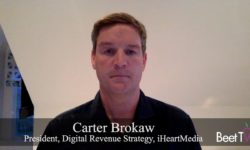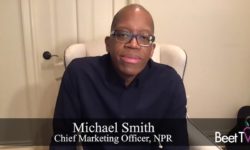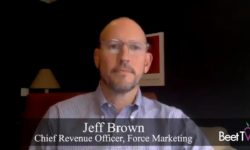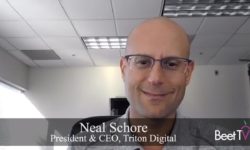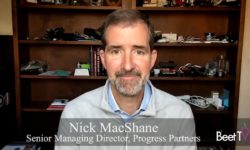it may have historically lacked the ability to track and target individual listeners, but radio’s intimacy has always made it a personal medium.
Now that audio listening channels can take advantage of digital signalling, many think that the unique properties of new-wave radio plus the addressability of digital can combine to make an appealing offer.
In this video interview with Beet.TV, Sarah Foss, the chief information officer of number-two US radio group Entercom, explains the attraction.
Turn up the volume
Audio is booming, with consumption growth coming from a range of devices and experiences:
- Smartphones on the go.
- In-ear gadgets like AirPods
- In-home smart speakers.
- In-car systems.
- Podcasts continuing their broader appeal, including Spotify introducing them to a wider audience.
The new-look audio universe benefits from programmatic and addressable advertising of the same kind that video has learned to adopt.
Audio is compelling
“One of the things that we’ve seen through COVID is audio is hot,” says Foss. “People are rediscovering radio, audio. They’re finding content in new ways that they can engage with through smart speakers in the home.
“Even though we’re not commuting in our cars, we’re still driving to get take-out food; we’re driving to go pick up things at the local grocery store.
“So it’s pervasive, how we can engage with really compelling audio content is everywhere. And consumers really have shown that because radio right now is the number one reach medium in the country.”
Consumer gambling and sports betting measure the direct impact of streaming audio. #EntercomInsights #audio #streaming #marketing #advertisinghttps://t.co/GR0qaAObSK
— AudacyCorp (@AudacyCorp) December 22, 2020
Radio reborn
Entercom was founded in 1968 and counts more than 230 radio stations in its portfolio. In 2017, it merged with CBS Radio, giving it use of Radio.com.
That has become its key asset in digital audio distribution, and for making an advertiser offer than can leverage first-party listener data.
“(Listeners are) engaging with us across all of the different platforms we have, whether that’s how they call in to a station for talk radio or how they sign up with email to participate in that live concert event via Zoom,” Foss says.
“We’ve actually built a data platform that allows us to finally look at our audience … with all that first party information we’re getting from our listeners across all of the different platforms that we have.”
Smart Speakers are leading the reinvention of at-home audio this holiday season. #audio #smartspeakers #media #marketinghttps://t.co/Gg7OquesPM
— AudacyCorp (@AudacyCorp) December 16, 2020
Addressable audio
Enabling addressability for radio is a big deal. For decades, the medium has boasted of in-built local targetability of sorts, by virtue of being pegged to local broadcast markets.
But first-party user data allows radio – the wider spectrum of audio more generally – to target individual listeners.
“Our visibility of the audiences we can deliver to advertisers is very robust,” Foss adds. “We’re starting to work with advertisers and agencies so that we can actually marry our first-party data with the data that they’re collecting so that we can truly connect the dots for holistic campaigns and actually show outcomes for (questions like) ‘When did the listener drive into the home goods store?’, ‘When did the listener actually from a smart speaker, then add something to a shopping list?’
“Those are the types of things that you can do now that we have our own first-party data, and we’re working very closely with advertisers with theirs.”
Digital audio trends
Foss’ observations are borne out by the trend data.
According to latest The Infinite Dial report from Edison Research and Triton Digital in March:
- 37% of Americans age 12+ (104 million) listen monthly, up from 32% in 2019.
- 62% of Americans use voice-operated assistants.
- 45% of Americans have listened to audio in a car through a cell phone.
According to The Smart Audio Report from Edison and NPR in April:
- 24% of American adults now have a smart speaker.
- 34% of non-owners said they were likely to buy a smart speaker within the next six months.
- 36% of smart speaker owners said they are using the device more for music and entertainment amid COVID-19, with 35% reporting the same for news and information.
From cross-scren, to cross-speaker
The key will be not repeating the problem in display and video advertising, in which an inability to create a cross-device profile for a single user has hampered targetability.
Foss says authenticated listening experiences – whether on speakers, in the caar or in the ear – will be the glue.
“Advertisers and agencies are saying, ‘That’s where we want to be’,” she says. “And they’re working with us on these data strategies so we can help them use their proprietary data sets with the information we have about our listeners across all of our platforms.
“It’s really exciting because we’re seeing sellouts on Radio.com. We’re seeing massive interest with people that are trying to target the local markets or the national audience overall.
“And so we have some very exciting platform growth from the listeners as well as from our advertisers and our agencies.”
You are watching “Advertisers: Turn Up the Volume on Streaming Audio,” a Beet.TV leadership series presented by TruOptik, a TransUnion company. For more videos, please visit this page.







